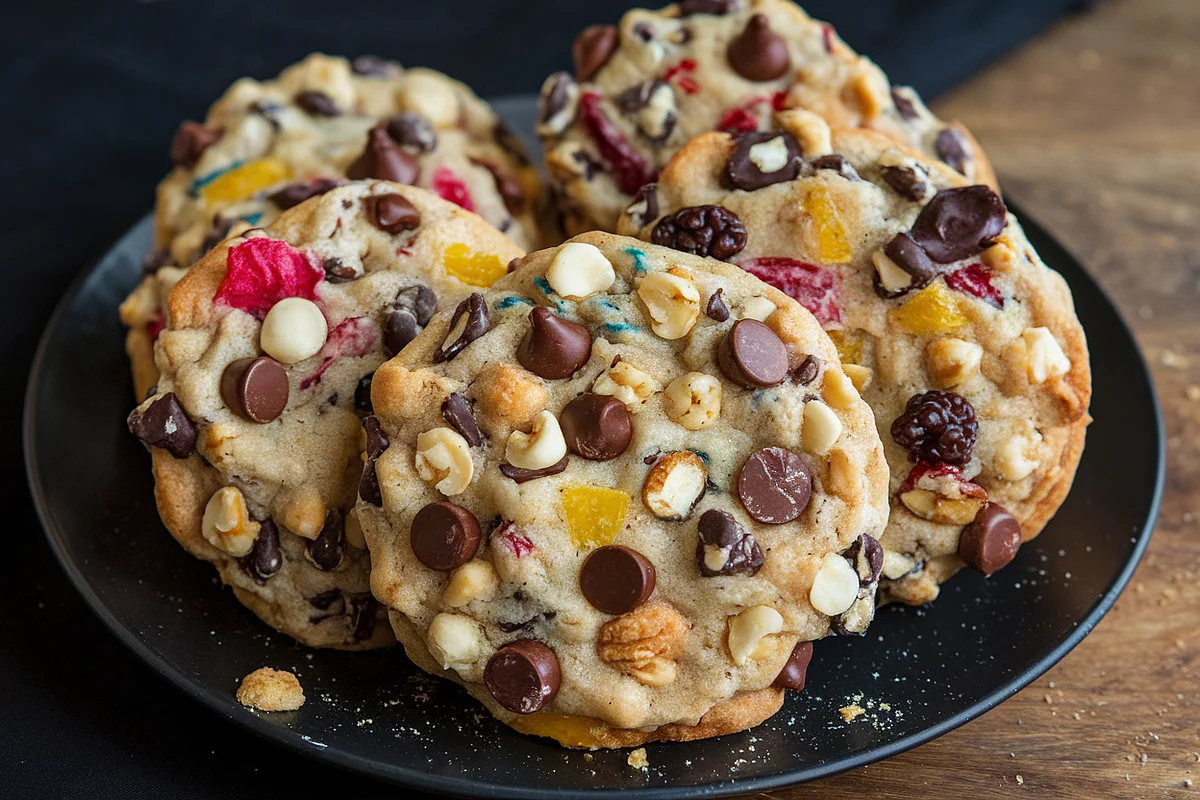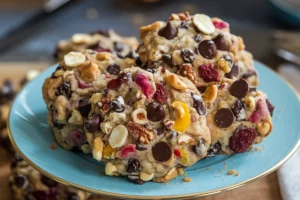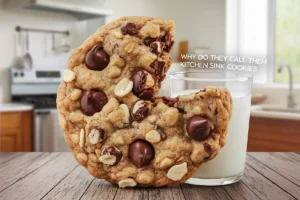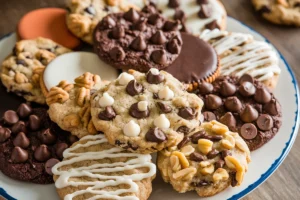Kitchen sink cookies have become a household favorite for many, offering a delightful combination of flavors in every bite. But have you ever wondered, why do they call them kitchen sink cookies? This term has an interesting origin that ties into the creativity and versatility of baking, where bakers can toss almost anything into these cookies—everything but the kitchen sink!
In this comprehensive article, we’ll explore the history of these iconic cookies, break down their ingredients, and reveal their cultural significance. We’ll also dive into fun facts, offer tips for making your own kitchen sink cookies, and answer some frequently asked questions.
Introduction to Kitchen Sink Cookies
Kitchen sink cookies are a true testament to the idea of culinary improvisation. They get their name from the phrase, “everything but the kitchen sink,” implying that you can add a wide variety of ingredients to the dough—whatever you have on hand in your kitchen.
Unlike other traditional cookies that follow specific ingredient lists, kitchen sink cookies thrive on flexibility. From chocolate chips to nuts, pretzels to butterscotch chips, and even potato chips, there’s no limit to what you can toss in. These cookies cater to bakers who love experimenting with flavors and textures, creating unexpected surprises in every bite.
Origin of the Name ‘Kitchen Sink Cookies’
The name kitchen sink cookies comes from the playful term used to describe a mix of ingredients thrown together. But why do they call them kitchen sink cookies exactly? The phrase everything but the kitchen sink symbolizes using leftover pantry ingredients, which is what home bakers started doing to create something delicious.
The concept of making cookies with a random assortment of ingredients likely began with home bakers looking to reduce food waste, creating delicious treats out of whatever was available in their kitchens. Over time, this creative approach to cookie-making became a beloved trend, particularly in American households.
As baking became more commercialized, famous brands and restaurants started offering their own variations of kitchen sink cookies, further popularizing the concept. Today, these cookies are not just a fun experiment but also a regular feature in many bakeries and coffee shops.
Check out the history of cookies for a deeper dive into how cookies, in general, have evolved over the centuries, shaping culinary traditions worldwide.
The Rise of Kitchen Sink Cookies in Modern Baking
You may have noticed kitchen sink cookies popping up in coffee shops and bakeries. But why do they call them kitchen sink cookies? The name stuck because of their signature characteristic—bakers use a wide variety of ingredients, throwing in anything they have available. This flexibility is what makes these cookies stand out in modern baking.
A notable example is how Starbucks added their own version of kitchen sink cookies to their menu, featuring ingredients like chocolate chunks, pretzels, and sea salt. This combination of sweet and salty flavors took the trend to new heights, appealing to a broad range of cookie lovers.
In professional kitchens, chefs often use these cookies as a way to experiment with flavor profiles and create signature desserts that can’t be found anywhere else. Regional variations also exist, with bakers in different parts of the world using local ingredients to put their own spin on this timeless treat.
Want to experiment with new cookie combinations? Here’s a helpful guide on ingredient substitutions for baking that can inspire you to try something new in your kitchen.
Comparison to Other Cookie Types
Kitchen sink cookies stand out from other types of cookies because they are meant to be a free-form, anything-goes type of dessert. Here’s how they compare to some other well-known cookie types:
- Oatmeal cookies: These are typically made with oats, cinnamon, and raisins, whereas kitchen sink cookies can incorporate a wide variety of mix-ins beyond the traditional.
- Chocolate chip cookies: While chocolate chips can be a common ingredient in kitchen sink cookies, the latter often includes many other ingredients like pretzels or toffee bits for added texture.
- Monster cookies: Similar to kitchen sink cookies in their hodgepodge nature, monster cookies usually contain peanut butter, M&M’s, oats, and chocolate chips. However, kitchen sink cookies allow for even more flexibility.
Kitchen sink cookies cater to bakers who enjoy the freedom to experiment without sticking to a single recipe. Their versatility makes them the ultimate comfort cookie for any occasion.
What Ingredients Go into Kitchen Sink Cookies?
The beauty of kitchen sink cookies is that you can use almost any ingredients you have on hand. However, there are a few staples that most kitchen sink cookies will include:
- Flour: All-purpose flour is typically the base.
- Sugar: Both brown and granulated sugar are commonly used to provide sweetness and moisture.
- Butter: Unsalted butter is preferred for a rich, creamy texture.
- Eggs: These act as a binder to hold the dough together.
- Vanilla Extract: Adds a subtle flavor that complements the sweetness.
From here, the mix-ins are where you get to have fun. Common ingredients include:
- Chocolate chips or chunks
- Toffee bits
- Chopped nuts (like pecans or walnuts)
- Pretzels
- Butterscotch chips
- Shredded coconut
- Potato chips
Feel free to get creative and add ingredients like dried fruit, candy bars, or even marshmallows. The possibilities are endless!
Popular Variations of Kitchen Sink Cookies
One of the most exciting aspects of kitchen sink cookies is how easy it is to adapt them to different dietary needs or flavor preferences. Here are some popular variations:
- Vegan Kitchen Sink Cookies: Substitute the butter with a vegan alternative like coconut oil or vegan margarine, and use a flax egg instead of a traditional egg.
- Gluten-Free Kitchen Sink Cookies: Swap the all-purpose flour with a gluten-free flour blend to make the cookies suitable for those with gluten sensitivities.
- Seasonal Variations: Add holiday-themed ingredients like peppermint pieces or pumpkin spice during the festive season for a seasonal twist.
Whether you’re looking to cater to a specific diet or simply want to try something new, there’s a kitchen sink cookie recipe for everyone.
How to Make the Perfect Kitchen Sink Cookie
Making the perfect kitchen sink cookie is all about balancing ingredients and baking times. Follow these expert tips to ensure your cookies turn out perfect every time:
- Use room temperature butter: This will help the dough come together smoothly and create a soft, chewy texture.
- Don’t overmix the dough: Overmixing can lead to tough cookies. Mix the dough just until the ingredients are incorporated.
- Chill the dough before baking: This step helps the cookies retain their shape while baking and prevents them from spreading too much.
- Monitor baking times: Depending on the size of the cookies, baking times may vary. Keep an eye on the edges; they should be lightly browned, while the centers remain soft.
With a few basic techniques, you’ll be on your way to baking the perfect batch of kitchen sink cookies that will wow your friends and family.
FAQs Section
Here are some frequently asked questions related to why they call them kitchen sink cookies:
- Why are they called kitchen sink cookies?
- They are called kitchen sink cookies because they are made using a variety of leftover ingredients you may have in your pantry, hence the idea of “everything but the kitchen sink.”
- What’s the origin of kitchen sink cookies?
- The origin of these cookies can be traced to home bakers looking for a way to use up leftover ingredients. The term “everything but the kitchen sink” became a popular phrase used to describe their versatility.
- Can I substitute ingredients in kitchen sink cookies?
- Absolutely! You can substitute ingredients based on your preferences or dietary needs. For example, you can replace chocolate chips with white chocolate, or nuts with dried fruit.
- How long can you store kitchen sink cookies?
- You can store kitchen sink cookies in an airtight container for up to 5 days at room temperature. If you want to keep them longer, store them in the freezer for up to 3 months.
- Are kitchen sink cookies vegan or gluten-free?
- They can be! You can easily adapt the recipe to make vegan or gluten-free kitchen sink cookies by substituting certain ingredients like butter or flour.
Cultural Significance of Kitchen Sink Cookies
In American baking culture, kitchen sink cookies have become a symbol of creativity and resourcefulness. They represent the idea that you can create something delicious out of a seemingly random collection of ingredients. This makes them a favorite for home bakers who want to try something new and for professional bakers who love experimenting with flavor combinations.
The popularity of kitchen sink cookies also speaks to our modern-day appreciation for flexibility in recipes, where rules can be bent, and new trends emerge with each passing year.
Fun Facts About Kitchen Sink Cookies
- Did you know? Some bakers add unusual ingredients like potato chips, cereal, and even pretzels to their kitchen sink cookies for an added crunch.
- Kitchen sink cookies are especially popular during the holidays, as they allow bakers to use up leftover ingredients from holiday treats.
- According to surveys, chocolate chips and nuts are the two most common ingredients found in kitchen sink cookies.
- There’s even a world record for the largest kitchen sink cookie, which was baked in a massive commercial oven and weighed over 300 pounds!
Conclusion
Why You Should Try Kitchen Sink Cookies Today
In conclusion, why do they call them kitchen sink cookies? The answer is simple: they’re a fun, versatile treat that allows you to mix in nearly anything you have on hand—truly an “everything but the kitchen sink” cookie. So, the next time you’re baking, embrace the freedom to get creative with your ingredients!
Their versatility makes them perfect for both experienced bakers and beginners who want to try something fun and flexible. With everything but the kitchen sink involved, there’s no wrong way to make these cookies. So, gather your favorite mix-ins, and give them a try today!



